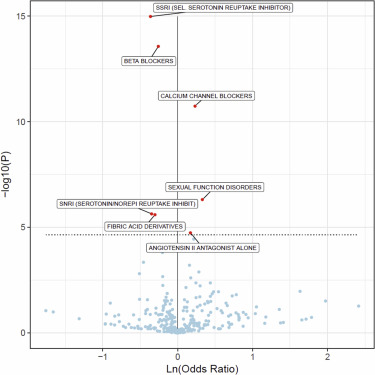Ophthalmology ( IF 13.1 ) Pub Date : 2018-02-09 , DOI: 10.1016/j.ophtha.2018.01.007 Wei Zheng , Thaddeus P. Dryja , Zhongyuan Wei , Dongying Song , Haijun Tian , Kristijan H. Kahler , Anthony P. Khawaja

|
Purpose
To identify associations between systemic medications and primary open-angle glaucoma (POAG) requiring a procedure using United States insurance claims data in a hypothesis-generating study.
Design
Database study.
Participants
In total, 6130 POAG cases (defined as patients with POAG undergoing a glaucoma procedure) were matched to 30 650 controls (defined as patients undergoing cataract surgery but without a coded glaucoma diagnosis, procedure, or medication) by age, gender, and region of residence.
Methods
Participant prescription drug use was calculated for the 5-year period before the glaucoma procedure or cataract surgery. Separately for individual generic drugs and drug classes, logistic regression was used to assess the association with POAG status. This was done across all generic drugs and drug classes that were prescribed in at least 1% of cases and controls. Analyses were adjusted for age, sex, region of residence, employment status, insurance plan type, and the total number of drugs prescribed.
Main Outcome Measures
Odds ratio (OR) and 95% confidence intervals (CIs) for the association between each drug or drug class and POAG.
Results
The median age of participants was 72 years, and 52% were women. We tested for associations of POAG with 423 drug classes and 1763 generic drugs, resulting in a total of 2186 statistical tests and a Bonferroni-adjusted significance threshold of P < 2.3 × 10−5. Selective serotonin reuptake inhibitors (SSRIs) were strongly associated with a reduced risk of POAG (OR, 0.70; 95% CI, 0.64–0.76; P = 1.0 × 10−15); the most significant drug in this class was citalopram (OR, 0.66; 95% CI, 0.57–0.77; P = 1.2 × 10−7). Calcium channel blockers were strongly associated with an increased risk of POAG (OR, 1.26; 95% CI, 1.18–1.35; P = 1.8 × 10−11); the most significant drug in this class was amlodipine (OR, 1.27; 95% CI, 1.18–1.37; P = 5.9 × 10−10).
Conclusions
We present data documenting potential associations of SSRIs and calcium channel blockers with POAG requiring a procedure. Further research may be indicated to better evaluate any associates of serotonin metabolism or calcium channels in glaucoma, or establish whether the associations are due to variations in the patterns for prescribing these drugs.
中文翻译:

系统性药物关联与推测的晚期或不受控制的原发性开角型青光眼
目的
为了确定系统药物与原发性开角型青光眼(POAG)之间的关联,该研究需要在一项假设产生的研究中使用美国保险理赔数据进行操作。
设计
数据库研究。
参加者
总共按年龄,性别和年龄段将6130例POAG病例(定义为接受青光眼手术的POAG患者)与30650例对照(定义为接受白内障手术但没有编码的青光眼诊断,程序或药物的患者)进行匹配。住宅。
方法
计算青光眼手术或白内障手术前5年的参与者处方药使用情况。对于个别通用药物和药物类别,分别使用逻辑回归分析评估与POAG状态的相关性。至少在1%的病例和对照中规定的所有仿制药品和药物类别中都进行了此操作。分析针对年龄,性别,居住地区,就业状况,保险计划类型和处方药总数进行了调整。
主要观察指标
每种药物或药物类别与POAG之间的关联的比值比(OR)和95%置信区间(CIs)。
结果
参与者的中位年龄为72岁,女性为52%。我们测试了POAG与423种药物类别和1763种非专利药物的关联性,总共进行了2186次统计测试,并且经Bonferroni调整后的显着性阈值为P <2.3×10 -5。选择性5-羟色胺再摄取抑制剂与降低POAG的风险密切相关(OR为0.70; 95%CI为0.64-0.76;P = 1.0×10 -15)。该类别中最重要的药物是西酞普兰(OR,0.66; 95%CI,0.57-0.77;P = 1.2×10 -7)。钙通道阻滞剂与POAG风险增加密切相关(OR为1.26; 95%CI为1.18-1.35; P = 1.8×10 -11); 此类药物中最重要的药物是氨氯地平(OR为1.27; 95%CI为1.18-1.37;P = 5.9×10 -10)。
结论
我们目前提供的数据记录了SSRI和钙通道阻滞剂与POAG需要程序的潜在关联。可能需要进行进一步的研究,以更好地评估青光眼中5-羟色胺代谢或钙通道的任何关联,或确定该关联是否归因于这些药物处方方式的变化。










































 京公网安备 11010802027423号
京公网安备 11010802027423号